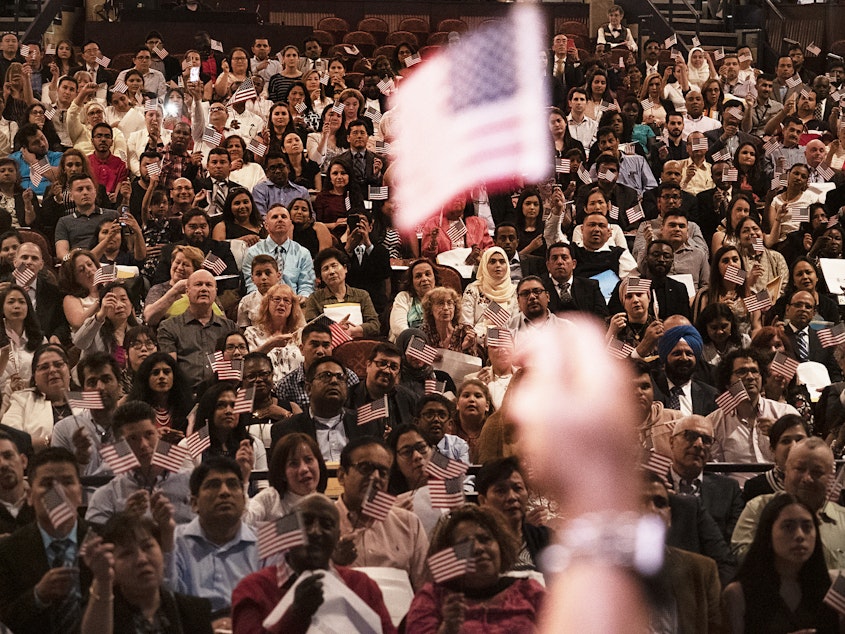How The U.S. Citizenship Oath Came To Be What It Is Today

Here's something to think about on this Fourth of July: If you are born in the United States, citizenship is a birthright, but if you immigrate to this country, the work of the citizenship process culminates in the reciting of an oath.
The U.S. citizenship oath consists of 140 words. Some of those are more contemporary, others more archaic. That's because the idea of the citizenship oath is almost as old as the Constitution itself.
The first naturalization law was passed in 1790, the year Rhode Island became the final of the original 13 colonies to ratify the Constitution and one year before the Bill of Rights was ratified.
"It permitted any free white person who lived in the United States for two years to petition the court to be a citizen," says Xiao Wang.
Wang is one of millions of people who have become naturalized U.S. citizens. His family came to the U.S. from China when he was 10 years old. Today, he's the CEO of Boundless Immigration, a Seattle-based technology company that helps immigrant families navigate a naturalization process that in 2018 saw nearly 757,000 people take the U.S. citizenship oath — a five-year high.
Sponsored
Wang says that when the naturalization process first began, applicants had to provide proof of their good character, pledge to support the Constitution and give up any allegiances to any other foreign state or sovereignty.
"On top of that, applicants who had a previous hereditary title or nobility actually had to renounce that as well to become a citizen of the U.S.," he says.
But while the 1790 naturalization law established a framework for becoming a citizen, it didn't implement a standard oath for the country, leaving the naturalization process varied from state to state for more than 100 years.
With no uniform process in place, a presidential commission was created in 1905 to study how to reform the country's naturalization process.
"Due to the high number of immigrants from all different locations spreading through all over and across the U.S., by then there was as many as 5,000 courts with naturalization jurisdiction, and each of these courts had developed its own processes for administering the oath," Wang says.
Sponsored
Many of the commission's recommendations were included in the Basic Naturalization Act of 1906, according to U.S. Citizenship and Immigration Services. While the recommendations still didn't lead to a standardized oath, at this point the decision was made to include language about defending "the Constitution and laws of the United States of America against all enemies, foreign and domestic; and bear true faith and allegiance to the same," according to the USCIS website.
It wasn't until 1929 that the oath's text was standardized. For much of the next two decades, the oath stayed the same. But with the U.S. facing a growing threat from the Soviet Union, the oath was amended in 1952 to emphasize service to country.
"There was an intent to make it more explicit that in becoming a citizen of the United States that you are also explicitly going to take action in defending this country when asked to," Wang says.
The three major changes, Wang says, included, "adding [a part] around bearing arms on behalf of the United States when required ... performing noncombatant services in the armed forces when required, and then the final one was added around performing work of national importance under civilian direction."
These changes still exist in the oath used today.
Sponsored
I hereby declare, on oath, that I absolutely and entirely renounce and abjure all allegiance and fidelity to any foreign prince, potentate, state, or sovereignty, of whom or which I have heretofore been a subject or citizen; that I will support and defend the Constitution and laws of the United States of America against all enemies, foreign and domestic; that I will bear true faith and allegiance to the same; that I will bear arms on behalf of the United States when required by the law; that I will perform noncombatant service in the Armed Forces of the United States when required by the law; that I will perform work of national importance under civilian direction when required by the law; and that I take this obligation freely, without any mental reservation or purpose of evasion; so help me God.
Wang has gone to many naturalization ceremonies and has heard the oath recited many times, including by his own parents. No matter how often he hears those 140 words, he says, they still have emotional significance to him.
"Words matter, and when you hear people say this, each of them are doing what my parents did, which is actually give up part of their identity," he says. "Something that they grew up with. Something that their family is."
As people take the oath, they are often embracing a new identity and completing a journey that has lasted years and possibly even decades, Wang says.
"It truly is something that matters deeply to each and every one of the individuals that say it," he says. "So when you see the tears on their faces, you can't help but feel them welling up in your own." [Copyright 2019 NPR]


